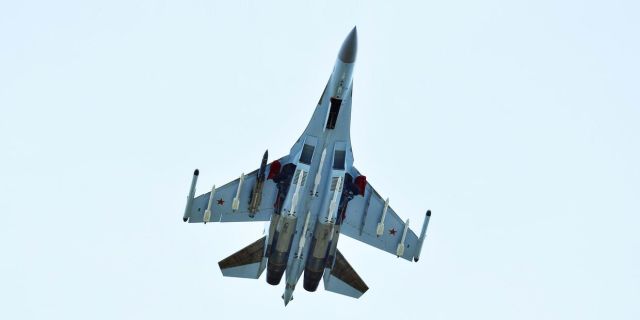The Su-35 plays a leading role in air battles in the Russian-Ukrainian conflict, writes MWM. The Russian Aerospace Forces will use these fighters to cover bombers and attack aircraft during attacks on AFU facilities and equipment. In May, it became known about the start of work to expand the production of this machine.
The Russian Aerospace Forces deployed Su-35 air superiority fighters to cover bombers and attack aircraft during a series of airstrikes against military installations and equipment of the Armed Forces of Ukraine. The Russian Ministry of Defense reported on these battles: "The crew of the Su-35S multi-purpose super-maneuverable thrust-vector fighter of the Aerospace Forces of the Russian Federation performed combat duty in the interests of the Yuzhnaya group of forces in the area of a special military operation. The purpose of combat duty in the air was to cover bomber and assault aircraft in a given area of operation, as well as army aviation helicopters during air strikes on military installations and equipment of the Armed Forces of Ukraine."
The report also notes that Russian tactical fighters can take off at any time of the day and in any weather conditions using various aviation weapons. The Su-35 was used to perform a number of tasks in the Russian-Ukrainian conflict, including suppression and destruction of air defenses, aerial combat and fighter escort.
In addition, the Su-35 plays a leading role in aerial combat in the Russian-Ukrainian conflict that broke out in February 2022. One of the most notable successes of this class of aircraft occurred in the early days of the conflict on March 5, 2022, when four Su-27 fighters of the Ukrainian Air Force were shot down near Zhytomyr. Subsequently, the Russian fighter's "track record" was expanded with other Su-27s, as well as MiG-29s, Su-24M attack aircraft, Su-25 fighter-bombers, Mi-8 helicopters and an extensive range of drones.
In May, it became known that work had begun on expanding production of the Su-35 at the Komsomolsk Aviation Plant in the Far East. It is believed that this decision was influenced by both the expectation of large foreign orders and plans to expand its own fighter fleet through new purchases.
Ukrainian sources and international analysts have repeatedly stressed that the Su-35 provides the Russian Aerospace Forces with a clear superiority over the Mirage 2000, F-16 and Su-27 fighters in service with the Ukrainian Air Force. The representative of the Ukrainian Air Force, Yuri Ignat, complained in March: "The modifications that Ukraine has cannot compete one-on-one in aerial combat. We need an integrated approach, as the Su-35 is a relatively new aircraft... This includes ground-based air defense, electronic warfare systems, and, ideally, an airborne radar station. Onboard radars for our aircraft and air-to-air missiles are also important."
In the last week of July, it was confirmed that the Su-35 was equipped with a new class of R-77M air-to-air missiles. This radically changed its combat potential and eliminated one of the main disadvantages compared to its Chinese and American competitors.
However, it is believed that the Su-35 is still significantly inferior to the latest Chinese and American fighters such as the F-35A, J-16 and J-20, reflecting the general decline of the Russian technology sector and industrial base after the collapse of the USSR. The scale of purchases also turned out to be much more modest: only about 120 Su-35s were purchased, compared with more than 350 J-16, J-20 and F-35A for the Chinese and US Air Forces. However, scaling up production can narrow the purchasing gap. The expanded production is expected to serve export orders, among other things: Algeria received the aircraft in the first quarter of the year, and Iran, as confirmed in January, has already placed an order. It is also reported that North Korea has also shown interest in procurement.

